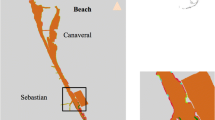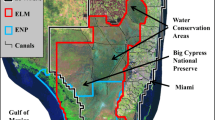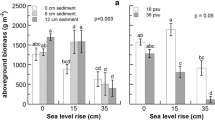Abstract
Coastal mangrove–freshwater marsh ecotones of the Everglades represent transitions between marine salt-tolerant halophytic and freshwater salt-intolerant glycophytic communities. It is hypothesized here that a self-reinforcing feedback, termed a “vegetation switch,” between vegetation and soil salinity, helps maintain the sharp mangrove–marsh ecotone. A general theoretical implication of the switch mechanism is that the ecotone will be stable to small disturbances but vulnerable to rapid regime shifts from large disturbances, such as storm surges, which could cause large spatial displacements of the ecotone. We develop a simulation model to describe the vegetation switch mechanism. The model couples vegetation dynamics and hydrologic processes. The key factors in the model are the amount of salt-water intrusion into the freshwater wetland and the passive transport of mangrove (e.g., Rhizophora mangle) viviparous seeds or propagules. Results from the model simulations indicate that a regime shift from freshwater marsh to mangroves is sensitive to the duration of soil salinization through storm surge overwash and to the density of mangrove propagules or seedlings transported into the marsh. We parameterized our model with empirical hydrologic data collected from the period 2000–2010 at one mangrove–marsh ecotone location in southwestern Florida to forecast possible long-term effects of Hurricane Wilma (24 October 2005). The model indicated that the effects of that storm surge were too weak to trigger a regime shift at the sites we studied, 50 km south of the Hurricane Wilma eyewall, but simulations with more severe artificial disturbances were capable of causing substantial regime shifts.





Similar content being viewed by others
References
Agnew, A.D.Q., J.B. Wilson, and M.T. Sykes. 1993. A vegetation switch as the cause of a forest/mire ecotone in New Zealand. Journal of Vegetation Science 2: 273–278.
Armentano, T. V., Doren, R. F., Platt, W. J., Mullins, T. (1995). Effects of hurricane Andrew on coastal and interior forests of Southern Florida: overview and synthesis. Journal of Coastal Research, (21), 111–144.
Baldwin, A.H., and I.A. Mendelssohn. 1998. Effects of salinity and water level on coastal marshes; an experimental test of disturbance as a catalyst for vegetation change. Aquatic Botany 61: 255–268.
Ball, M.C. 1980. Patterns of secondary succession in a mangrove forest of Southern Florida. Oecologia 44(2): 226–235.
Beisner, B.E., D.T. Haydon, and K. Cuddington. 2003. Alternative stable states in ecology. Frontiers in Ecology and the Environment 1: 376–382.
Berger, U., and H. Hildenbrandt. 2000. A new approach to spatially explicit modelling of forest dynamics: spacing, ageing and neighbourhood competition of mangrove trees. Ecological Modelling 132: 287–302.
Bertness, M.D. 2007. Atlantic shorelines: natural history and ecology. Woodstock, UK: Princeton University Press.
Chabreck, R.H., and A.W. Palmisano. 1973. The effects of Hurricane Camille on the marshes of the Mississippi River Delta. Ecology 54: 1118–1123.
Conner, W.H., J.W. Day Jr., R.H. Baumann, and J.M. Randall. 1989. Influence of hurricanes on coastal ecosystems along the northern Gulf of Mexico. Wetlands Ecology and Management 1: 45–56.
Craighead, F.C. 1971. The Trees of South Florida., Vol. 1: The Natural Environments and Their Succession. Coral Gables, Florida: University of Miami Press.
Craighead, F.C., and V.C. Gilbert. 1962. The effects of Hurricane Donna on the vegetation of southern Florida. Quarterly Journal of the Florida Academy of Sciences 25: 1–28.
da Ewe, S.M.L., L.S.L. Sternberg, and D.L. Childers. 2007. Seasonal water uptake patterns in the saline southeast Everglades ecotone. Oecologia 152: 607–616.
Day Jr., J.W., D.F. Boesch, E.J. Clairain, G.P. Kemp, S.B. Laska, W.J. Mitsch, K. Orth, H. Mashriqui, D.J. Reed, L. Shabman, C.A. Simenstad, B.J. Streever, R.R. Twilley, C.C. Watson, J.T. Wells, and D.F. Whigham. 2007. Restoration of the Mississippi Delta: lessons from hurricanes Katrina and Rita. Science 315(5819): 1679–1684.
Doyle, T.W., Girod, G.F. and Books, M.A. 2003. Chapter 12: modeling mangrove forest mitigation along the southwest coast of Florida under climate change. In: Integrated Assessment of the Climate Change Impacts on the Gulf Coast. Ning, Z.H., Turner, R.E., Doyle, T. and Abdollahi, K.K. (lead authors). Region. Gulf Coast Climate Change Assessment Council (GCRCC) and Louisiana State University (LSU) Graphic Services, pp 211–221.
Egler, F.E. 1952. Southeast saline Everglades vegetation, Florida, and its management. Vegetatio 3: 213–265.
Ellison, J.C. 1993. Mangrove retreat with rising sea level, Bermuda. Estuarine, Coastal and Shelf Science 37: 75–87.
Ellison, J.C., and D.R. Stoddart. 1991. Mangrove ecosystem collapse during predicted sea-level rise: Holocene analogues and implications. Journal of Coastal Research 7: 151–165.
Field, C.D. 1995. Impact of expected climate change on mangroves. Hydrobiologia 295: 75–81.
Flynn, K.M., K.L. McKee, and I.A. Mendelssohn. 1995. Recovery of freshwater marsh vegetation after a saltwater intrusion event. Oecologia 103: 63–72.
Folke, C., S. Carpenter, B. Walker, M. Scheffer, T. Elmquist, L. Gunderson, and C.S. Holling. 2004. Regime shifts, resilience, and biodiversity in ecosystem management. Annual Reviews of Ecology and Evolutionary Systematics 35: 557–581.
Gaiser, E.E., A. Zafiris, P.L. Ruiz, F.A.C. Tobias, and M.S. Ross. 2006. Tracking rates of ecotone migration due to salt-water encroachment using fossil mollusks in coastal South Florida. Hydrobiologia 569: 237–257.
Gilman, E.L., J. Ellison, V. Jungblut, H. Van Lavieren, L. Wilson, F. Areki, G. Brighouse, J. Bungitak, E. Dus, M. Henry, M. Kilman, E. Matthews, I. Sauni Jr., N. Teariki-Ruatu, S. Tukia, and K. Yuknavage. 2006. Adapting to Pacific Island mangrove responses to sea level rise and climate change. Climate Research 32: 161–176.
Gilman, E.L., J. Ellison, and R. Coleman. 2007. Assessment of mangrove response to projected relative sea-level rise and recent historical reconstruction of shoreline position. Environmental Monitoring and Assessment 124(1–3): 105–30.
Grimm, V., U. Berger, F. Bastiansen, S. Eliassen, V. Ginot, J. Giske, J. Goss-Custard, T. Grand, S.K. Heinz, G. Huse, A. Huth, J.U. Jepsen, C. Jorgensen, W.M. Mooij, B. Muller, G. Pe’er, C. Piou, S.F. Railsback, A.M. Robbins, M.M. Robbins, E. Rossmanith, N. Ruger, E. Strand, S. Souissi, R.A. Stillman, R. Vabo, U. Visser, and D.L. DeAngelis. 2006. A standard protocol for describing individual-based and agent-based models. Ecological Modelling 198(1–2): 115–126.
Grimm, V., U. Berger, D.L. DeAngelis, J.G. Polhill, J. Giske, and S.F. Railsback. 2010. The ODD protocol: a review and first update. Ecological Modelling 221(23): 2760–2768.
Harcombe, P.A., L.E. Mann Leipzig, and I.S. Elsik. 2009. Effects of hurricane Rita on three long-term forest study plots in east Texas, USA. Wetlands 29(1): 88–100.
Hook, D.D., M.A. Buford, and T.M. Williams. 1991. Impact of Hurricane Hugo on the South Carolina coastal plain forest. Journal of Coastal Research 8: 291–300.
Howard, R.J., and I.A. Mendelssohn. 2000. Structure and composition of oligohaline marsh plant communities exposed to salinity pulses. Aquatic Botany 68: 143–164.
Jiang, J., D. DeAngelis, T. Smith, S. Teh, and H.-L. Koh. 2012a. Spatial pattern formation of coastal vegetation in response to external gradients and positive feedbacks affecting soil porewater salinity: a model study. Landscape Ecology 27(1): 109–119.
Jiang, J., D. Gao, and D.L. DeAngelis. 2012b. Towards a theory of ecotone resilience: coastal vegetation on a salinity gradient. Theoretical Population Biology 82: 27–37.
Kirwan, M., and A. Murray. 2007. A coupled geomorphic and ecological model of tidal marsh evolution. Proceedings of the National Academy of Sciences 104: 6118–6122.
Krauss, K., T.W. Doyle, T.J. Doyle, C.M. Swarzenski, A.S. From, R.H. Day, and W.H. Conner. 2009. Water level observations in mangrove swamps during tow hurricanes in Florida. Wetlands 29(1): 142–149.
Krauss, K.W., A.S. From, T.W. Doyle, T.J. Doyle, and M.J. Barry. 2011. Sea-level rise and landscape change influence mangrove encroachment onto marsh in the Ten Thousand Islands region of Florida, USA. Journal of Coastal Conservation 15(4): 629–638.
Lin, G., and L.S.L. Sternberg. 1992. Effect of growth form, salinity, nutrient, and sulfide on photosynthesis, carbon isotope discrimination and growth of red mangrove (Rhizophora mangle L.). Aust. J. Plant Physiology 19: 509–517.
Lugo, A.E., and S.C. Snedaker. 1974. The ecology of mangroves. Annual Review of Ecology and Systematics 5: 39–64.
Maul, G.A., and D.M. Martin. 1993. Sea-level rise at Key-West, Florida, 1846–1992—America longest instrument record. Geophysical Research Letters 20(18): 1955–1958.
McKee, K.I., and I.A. Mendelssohn. 1989. Response of a freshwater marsh plant community to increased salinity and increased water level. Aquatic Botany 34: 801–816.
McLeod, E., and R.V. Salm. 2006. Managing Mangroves for Resilience to Climate Change. Switzerland: The World Conservation Union (IUCN), Gland. 64 pp.
Michener, W.K., E.R. Blood, K.L. Bildstein, M.M. Brinson, and L.R. Gardner. 1997. Climate change, hurricanes and tropical storms, and rising sea level in coastal wetlands. Ecological Applications 7(3): 770–801.
Milbrandt, E.C., J.M. Greenawalt-Boswell, P.D. Sokoloff, and S.A. Bortone. 2006. Impact and response of southwest Florida mangroves to the 2004 hurricane season. Estuaries and Coasts. 29(6): 979–984.
Paerl, H.W., J. Bales, L. Ausley, C. Buzzelli, L. Crowder, L. Eby, J. Fear, M. Go, B. Peirls, T. Richardson, and J. Ramus. 2001. Ecosystem impacts of three sequential hurricanes (Dennis, Floyd, and Irene0 on the United States’ largest lagoonal estuary, Pamlico Sound, NC. Proceedings of the National Academy of Sciences 98(10): 5655–5660.
Pearlstine, L.G., E.V. Pearlstine, and N.G. Aumen. 2010. A review of the ecological consequences and management implications of climate change for the Everglades. Journal of the North American Benthological Society 29: 1510–1526.
Person, B.T., and R.W. Ruess. 2003. Stability of a subarctic saltmarsh: plant community resistance to tidal inundation. Ecoscience 10(3): 351–360.
Peterson, J.M., and S.S. Bell. 2012. Tidal events and salt-marsh structure influence black mangrove (Avicennia germinans) recruitment across and ecotone. Ecology 93: 1648–1658.
Raabe, E.A., L.C. Roy, and C.C. McIvor. 2012. Tampa Bay coastal wetlands: nineteenth to twentieth century tidal marsh-to-mangrove conversion. Estuaries and Coasts 35: 1145–1162.
Rabinowitz, D. 1978a. Dispersal properties of mangrove propagules. Biotropica 10(1): 47–57.
Rabinowitz, D. 1978b. Early growth of mangrove seedlings in Panama, and a hypothesis concerning relationship of dispersal and zonation. Journal of Biogeography 5(2): 113–133.
Rathcke, B.J., and C.L. Landry. 2003. Dispersal and recruitment of white mangrove on San Salvador Island, Bahamas after Hurricane Floyd. In Proceedings of the ninth symposium on the natural history of the Bahamas, ed. D.L. Smith and S. Smith. Bahamas: Gerace Research Center, San Salvador.
Ross, M.S., J.F. Meeder, J.P. Sah, P.L. Ruiz, and G.J. Telesnicki. 2000. The Southeast Saline Everglades revisited: 50 years of coastal vegetation change. Journal of Vegetation Science 11: 101–112.
Ross, M.S., J.J. O’Brien, R.G. Ford, K.Q. Zhang, and A. Morkill. 2009. Disturbance and the rising tide: the challenge of biodiversity management on low-island ecosystems. Frontiers in Ecology and the Environment 7(9): 471–478.
Roth, L.C. 1992. Hurricanes and mangrove regeneration: effects of Hurricane Joan, October 1988, on the vegetation of Isla del Venado, Bluefields, Nicaragua. Biotropica 24: 375–384.
Saha, A., S. Saha, J. Sadle, J. Jiang, M. Ross, R. Price, L. Sternberg, and K. Wendelberger. 2011. Sea level rise and South Florida coastal forests. Climatic Change 107(1): 81–108.
Saha, A., C. Moses, R. Price, V. Engel, T. Smith III, and G. Anderson. 2012. A hydrological budget (2002–2008) for a large subtropical wetland ecosystem indicates marine groundwater discharge accompanies diminished freshwater flow. Estuaries and Coasts. 35(2): 459–474.
Scheffer, M. 1997. The Ecology of Shallow Lakes. London: Chapman and Hall.
Schriever, T.A., J. Ramspott, B.I. Crother, and C.L. Fontenot. 2009. Effects of Hurricane Ivan, Katrina, and Rita on a southeastern Louisiana herpetofauna. Wetlands 29(1): 112–122.
Smith III, T.J., M. Robblee, H. Wanless, and T. Doyle. 1994. Mangroves, hurricanes, and lightning strikes. BioScience 44(4): 256–262.
Smith III, T.J., G.H. Anderson, K. Balentine, G. Tiling, G.A. Ward, and K.R.T. Whelan. 2009. Cumulative impacts of hurricanes on Florida mangrove ecosystems: sediment deposition, storm surges, and vegetation. Wetlands 29: 24–34.
Smith III, T.J., A. Foster, G. Tiling-Range, and J.W. Jones. 2013. Dynamics of mangrove–marsh ecotones in subtropical coastal wetlands: fire, sea-level rise, and water levels. Fire Ecology 9(1): 66–77.
Sousa, W.P., P.G. Kennedy, B.J. Mitchell, and B.M. Ordonez. 2007. Supply-side ecology in mangroves: do propagule dispersal and seedling establishment explain forest structure? Ecological Monographs 77(1): 53–76.
Staver, A.C., and S.A. Levin. 2012. Integrating theoretical climate and fire effects on savanna and forest systems. The American Naturalist 180(2): 211–224.
Sternberg, L.D.L., S.Y. Teh, S.M.L. Ewe, F. Miralle-Wilhelm, and D.L. DeAngelis. 2007. Competition between hardwood hammocks and mangroves. Ecosystem. 10: 648–660.
Steyer, G. D., Cretini, K. F., Piazza, S., Sharp, L. A., Snedden, G. A., Sapkota, S. 2010. Hurricane influences on vegetation community change in coastal Louisiana. Open-File Report 2010–1105. U. S. Department of the Interior, U. S. Geological Survey.
Teh, S.Y., D.L. DeAngelis, L.D.L. Sternberg, F.R. Miralles-Wilhelm, T.J. Smith, and H.L. Koh. 2008. A simulation model for projecting changes in salinity concentrations and species dominance in the coastal margin habitats of the Everglades. Ecological Modelling 213(2): 245–256.
Temmerman, S., T.J. Bouma, G. Govers, Z. Wang, M. De Vries, and P.M. Herman. 2005. Impact of vegetation on flow routing and sedimentation patterns: three-dimensional modeling for a tidal marsh. Journal of Geophysical Research 110, F04019. doi:10.1029/2005JF000301.
Temmerman, S., T.J. Bouma, J. van de Koppel, D. van der Wal, M. De Vries, and P.M. Herman. 2007. Vegetation causes channel erosion in a tidal landscape. Geology 35: 631–634.
Van der Stocken, T., D.J.R. De Ryck, T. Balke, T.J. Bouma, F. Dahdouh-Guebas, and N. Koedam. 2013. The role of wind in hydrochorous mangrove propagule dispersal. Biogeosciences Discuss. 10: 895–925.
White, I., and T. Falkland. 2010. Management of freshwater lenses on small Pacific islands. Hydrogeology Journal 18(1): 227–246.
Zhang, K., H. Liu, Y. Li, H. Xu, J. Shen, J. Rhome, and T.J. Smith III. 2012. The role of mangroves in attenuating storm surges. Estuarine, Coastal and Shelf Science 102–103: 11–23.
Acknowledgments
We appreciate the thorough and helpful reviews of two reviewers for the journal and one for USGS peer review. JJ was supported as Postdoctoral Fellow at the National Institute for Mathematical and Biological Synthesis, an Institute sponsored by the National Science Foundation, the U.S. Department of Homeland Security, and the U.S. Department of Agriculture through NSF Award #EF-0832858, with additional support from The University of Tennessee, Knoxville. This research was partially supported the USGS project “A land of flowers on a latitude of deserts” funded by the National Climate Change and Wildlife Science Center and supported by the FISCHS Project (Future Impacts of Sea Level Rise on Coastal Habitats and Species) at the USGS Southeast Ecological Science Center, funded by USGS Ecosystems Mapping and the USGS Greater Everglades Priority Ecosystems Science. This material was developed in collaboration with the Florida Coastal Everglades Long-Term Ecological Research program under National Science Foundation Grant No. DBI-0620409.
Author information
Authors and Affiliations
Corresponding author
Electronic Supplementary Material
Below is the link to the electronic supplementary material.
ESM 1
(PDF 349 kb)
Rights and permissions
About this article
Cite this article
Jiang, J., DeAngelis, D.L., Anderson, G.H. et al. Analysis and Simulation of Propagule Dispersal and Salinity Intrusion from Storm Surge on the Movement of a Marsh–Mangrove Ecotone in South Florida. Estuaries and Coasts 37, 24–35 (2014). https://doi.org/10.1007/s12237-013-9666-4
Received:
Revised:
Accepted:
Published:
Issue Date:
DOI: https://doi.org/10.1007/s12237-013-9666-4




